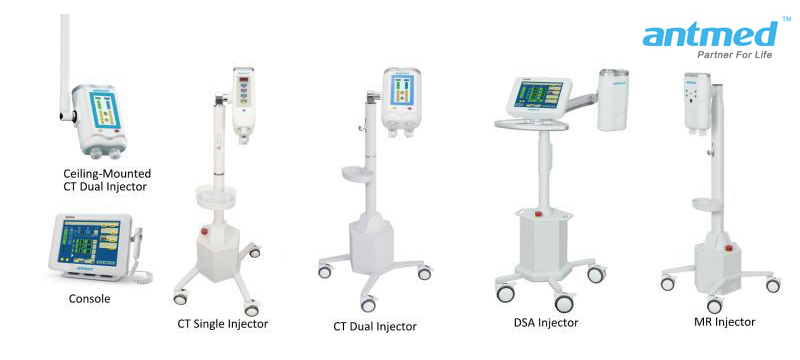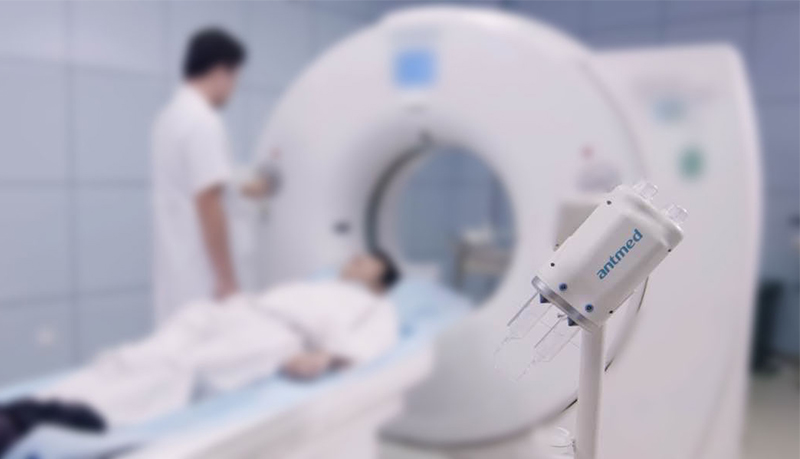Modern advanced high pressure injector adopts computer program control mode. It is equipped with multiple sets of multi-stage injection programs that can be memorized. All injection syringes are “disposable sterile high pressure syringes”, and are equipped with pressure connecting tubes, which can scan and inject medicine at the same time. It has the advantages of high automation and high accuracy. It can adjust the injection rate at will according to different parts and different pathological properties. It can quickly inject contrast agent into arteries and veins, which are distributed in various blood vessels. At the same time of injection, it can perform CTA scanning to improve the diagnosis rate of diseases.
1. Operation method
In the CT treatment room, use a 2ml syringe to suck 2ml of 0.9% NaCl solution, then connect the intravenous catheter, use G18-22 IV catheter for venipuncture, select the thick, straight and elastic vessels of the radial vein of the upper limb, the basilic vein, and the median cubital vein as the IV catheter for puncture, properly fix them after success. And then use a 2ml syringe to suck 1ml of 0.1% meglumine diatrizoate contrast agent through intravenous injection. Observe the test results 20 minutes later, Negative reaction: no transient chest tightness, nausea, urticaria, rhinitis, and normal complexion and vital signs shall be placed in the CT examination room. The CT examination room is Philips 16 row spiral CT, a high pressure CT injector of Shenzhen Antmed Co., Ltd., which injects the drug Ossurol. (1) Before operation, turn on the power switch and install the disposable high pressure syringes (double syringes). Syringe A inhales 200ml of iodofol media, and syringe B inhales 200ml of 0.9% sodium chloride solution. Connect the two injection syringes with the three-way connecting tube, exhaust the air in the syringe and the tube, and then connect with the patient’s intravenous catheter. After the blood is well drawn back again, put the injector head down for standby. (2) According to the patient’s different weight and different enhanced scanning positions, touch programming is carried out on the LCD screen to set the total amount and flow rate of the injection solution and saline injection of the high pressure syringe. The total amount of iodoform injection is 60-200 ml, the total amount of 0.9% sodium chloride solution is 80-200 ml, and the injection rate is 3 – 3.5 ml/s. After the programming is completed, the scanning operator will issue a command to start the injection. First, iodoform media is injected, rinse again with 0.9% sodium chloride solution until the scanning is completed.
Shenzhen Antmed Co., Ltd High Pressure Injector product line:
2. Preparation before CTA scanning
Ask the patient if he has any history of allergy to other drugs, hyperthyroidism, hypertension, heart disease, diabetes nephropathy, renal insufficiency, insufficient blood volume, hypoalbuminemia and other high-risk factors of angiography, and explain the purpose and role of enhanced scanning to the patient and his family. The patient needs to have an empty stomach for 4 hours before the enhanced scanning examination, and those who have undergone barium meal fluoroscopy for 3 to 7 days but have not discharged the barium are not allowed to have abdominal and pelvic scanning. When performing CTA scanning of chest and abdomen, it is necessary to hold your breath to reduce or avoid non stratification and artifacts. Breathing training should be carried out in advance and asked to hold your breath at the end of inspiration.
3. Do a good job of psychological care, and introduce to patients that the pressure of the high pressure injector injection is greater than the pressure of hand pushing, and the speed is faster. The blood vessels at the injection site may collapse, causing the leakage of liquid medicine, edema, numbness, pain, and some may develop into ulceration and tissue necrosis. Secondly, when injecting the high pressure injector, there is a potential danger that the injection catheter will fall off, resulting in the leakage of liquid medicine and loss of dosage. The patient’s nursing staff was also informed that they could carefully select the appropriate vein, operate carefully, and select the appropriate type of IV catheter according to the patient’s vascular conditions. When using the high pressure injector, the turnbuckles between the syringe barrel and the piston bolt were firm, the three-way connecting tube was tightly connected with the syringe and all interfaces of the IV catheter, and the needle head was properly fixed. Eliminate the patient’s nervousness, obtain cooperation, and finally ask the patient’s family members to sign the informed consent form for CTA scanning.
4. Precautions during CTA inspection
1). Prevention of liquid medicine leakage: when the scanner is moving, the connecting tube shall not be squeezed or pulled, and the puncture part shall not be collided to avoid liquid medicine leakage. After the determination of the scanning center, the nurse should check the placement of the catheter needle into the vein again, inject 10~15ml of 0.9% sodium chloride solution under moderate pressure manually to see if it is smooth, ask the patient again for any discomfort such as swelling pain and palpitation, and give psychological counseling to comfort the patient that the medical staff will pay attention to you from the beginning to the end of the scanning, so that they can easily cope with the examination and eliminate tension and fear. During drug injection, the nurse should closely observe the patient’s facial expression, drug leakage, allergic reaction, etc. If there is an accident, the injection and scanning should be interrupted at any time.
2) Prevent air injection: Improper exhaust will lead to air embolism. Air embolism is a serious complication during CTA scanning, which can lead to death of patients. Be careful during operation. All interfaces must be tightened to prevent them from splitting under high pressure. Before injection, the air in the two syringes, three-way connecting tubes and catheter needles must be emptied. During injection, the injection head is downward, so that some small bubbles float to the tail of the syringe. The injection amount is less than the amount of inhaled medicine and 0.9% sodium chloride solution. 1~2ml of liquid medicine should remain in the syringe to prevent air from being pressed into the patient’s blood vessels during high pressure injection.
3) Prevention of cross infection in hospital: one patient, one needle and one double syringes must be achieved when performing CTA scanning, and the sterile operation principle must be strictly followed.
4) Notification after scanning
a. After scanning, ask the patient to rest in the observation room, keep the intravenous catheter for 15~30min, and pull it out after no adverse reaction. The CT treatment room must be prepared with first-aid medicine and first-aid equipment. If you feel unwell, go to the doctor immediately to prevent the occurrence of delayed anaphylaxis and adverse consequences. The patient was also instructed to drink plenty of water to promote the excretion of contrast agent as soon as possible and reduce the adverse reaction to the kidney.
b. In CTA scanning, although the application of high pressure injector has certain risks, it is safe, reliable and can play a unique clinical role with appropriate preventive measures to avoid risks. It is a must for modern CT room nursing. The nursing staff in CT room must have a strict and serious attitude when working. They must abide by the operating procedures of high pressure injectors during operation. They must repeatedly check many links such as drug suction, exhaust, puncture and fixation to ensure that they are correct. The injection dose, flow rate and continuous injection time must be accurate. So as to ensure that patients successfully complete CTA examination. The application of high pressure injector in imaging inspection can improve the qualitative ability of small lesions and complex cases, provide doctors with disease diagnosis and differential diagnosis basis, improve the accuracy of disease diagnosis, and provide more accurate treatment basis for clinical diagnosis and treatment.
For more information about our products and services, please contact us at info@antmed.com.
Post time: Oct-27-2022



